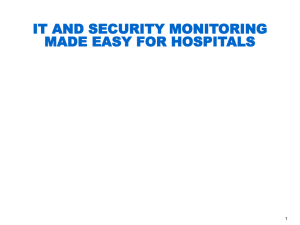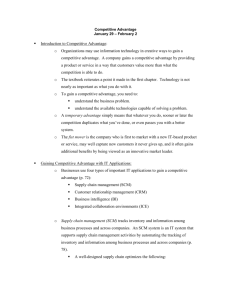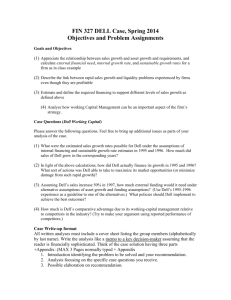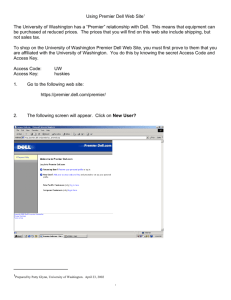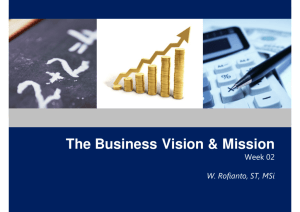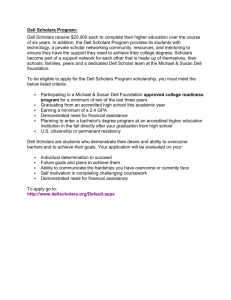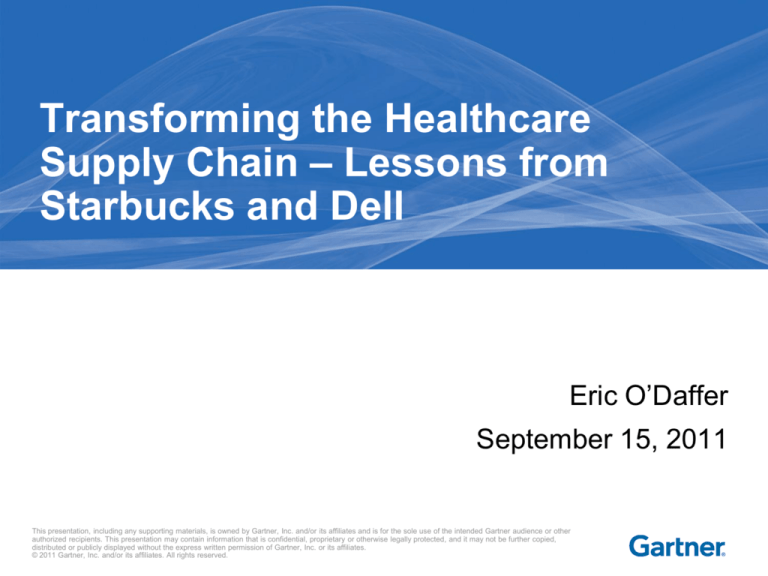
Transforming the Healthcare
Supply Chain – Lessons from
Starbucks and Dell
Eric O’Daffer
September 15, 2011
This presentation, including any supporting materials, is owned by Gartner, Inc. and/or its affiliates and is for the sole use of the intended Gartner audience or other
authorized recipients. This presentation may contain information that is confidential, proprietary or otherwise legally protected, and it may not be further copied,
distributed or publicly displayed without the express written permission of Gartner, Inc. or its affiliates.
© 2011 Gartner, Inc. and/or its affiliates. All rights reserved.
Learning Objectives
• Highlight two well known brands and their supply
chain transformation. Relate these
transformations to healthcare providers.
• Identify the stages of transformation in supply
chain and the challenges inherent to healthcare
providers in this evolution.
• Discuss the intersection of patient outcomes, cost
and reimbursement and the challenges the
healthcare value chain faces in incorporating
these critical data points.
1
Healthcare Value Chain Capabilities Model
Value Chain Goal:
High Quality Patient Care at Optimal Economic Cost
Patient
Focus
Outcome Focused
Comparative
Effectiveness
Collaboration
Shared Vision and
Goals
Sustainable
Collaborative
Relationships
Network
Visibility
Dynamic
Supply
Change
Management
Demand
Segmented Supply
Chains
Vision
Inventory
Compliance
Value Added
Services
Joint Value Creation
Leadership
Guiding Metrics
Innovation Culture
Foundational Capabilities
Operations & Innovation Excellence
Business Process Optimization
Enabling Technologies
Governance
Value Chain Transformation Journey
Responsive to demand
Growth and profitability
Cost to deliver
Cost to serve
• Profitable perfect orders.
growth
supply chain
IT
procurement
engineering
supply
Internally Focused
Business
Externally Focused
• Perfect orders.
• Profitability (SKU/shelf/account/segment/launch).
Demand Driven
Value Driven
Build and extend core
Joint value,
demand management
outcome-focused
processes.
performance
management.
3 4
Cost Focused
2 1
Business Unit
Focused
Integrate
and consolidate
business process
infrastructure.
Cost Focused
•Acquire, merge, partner.
•Legacy growth.
•Business units and functions.
Revenue Focused
Starbucks Today
Explosive Growth Leading Up to 2008
The Recession Happened and Everything
Changed in 2008
U.S. Sales
Supply Costs
Supply Chain Performance
Four Key Issues for Starbucks
• Supply chain strategy
- Operational plan
- Organizational structure
- Leadership principles
- Strategic framework
• Calibration of organizational benefits
• Supply chain metrics
• Talent enhancement/acquisition investments
Starbucks' Supply Chain Purpose (Objectives)
Starbucks Modified Its
Organizational Structure
Plan – Make – Source – Deliver
Modified Leadership Principles
• Highlight problems.
• Encourage transparency.
• Sleep well.
Calibration of the Benefit Opportunities
Three percent year-over-year improvement
in cost of goods sold creates over
$500 million in cumulative value.
Supply Chain Metrics
Strategic Framework
Key Lessons Learned:
Starbucks' Improvement to Great
• Explosive growth hid a multitude of supply
chain ills.
• Individual departmental goals and metrics caused
conflicting activities, and mitigated improvements.
• Traditional definitions of plan, source, make and
deliver lead to parity. Moving to an integrated
view transforms to industry-leading performance.
• Establishing a strategy framework drives
enterprise alignment and progress.
• Investments in talent return significant results.
Dell – Overview and Challenge
• $61B Company in 166 Countries. 5.4 million
customer interactions every day.
• Dell revolutionized supply chain management
with its direct model, configure-to-order (CTO)
manufacturing, just-in-time inventory model and
impressive cash-to-cash conversion cycle.
• The company has been a staple in the top five of
the AMR Supply Chain Top 25 every year since it
started in 2004.
15
Dell – Supply Chain Challenge
The Challenge:
Demand for commoditized products, changes in customer channel preferences
emerging market growth, component cost declines, a more capable supply base
and globalization have challenged the singular supply chain.
•
Long-term demand sensing to continually refine its portfolio
- Leverage Dell's direct model provided extensive customer insights, with over two
billion online customer visits per year.
- Determine how to predict where the market was headed, define a three-year
outlook of customer needs and support multiple global customer groups.
•
Supply chain design for a new environment
- Address changing business strategy, product commoditization and proliferation,
emerging markets, global supply networks and multichannel sales and fulfillment.
•
Complexity reduction
- Develop an end-to-end, "low-cost" supply chain focused on efficiency
- Maintain responsive heritage provided by its CTO capability
16
2007
Configure to
Order
Direct Model
Dell Supply
Chain
Transformation
2008
2009
Optimized by Product &
Region
2010
2011+
•Configurability with a cost advantage
•Exclusively Dell owned & operated
•One Size Fits All
•Fixed Cost Structure
Global Organization Structure
Variabilize Cost Structure
• Expand partner network
• Leverage partner capabilities
Global IT Infrastructure Optimization
• Global, standard IT infrastructure
Customer Value - Segmented Supply
Chain
• Establish the ability to segment offerings to customer
• Deliver value, choices & services – Cost to Serve
• Optimize complexity
Optimized by Process & Customer
This presentation, including any supporting materials, is owned by Gartner, Inc. and/or its affiliates and is for the sole use of the intended Gartner audience or other
authorized recipients. This presentation may contain information that is confidential, proprietary or otherwise legally protected, and it may not be further copied,
distributed or publicly displayed without the express written permission of Gartner, Inc. or its affiliates.
© 2011 Gartner, Inc. and/or its affiliates. All rights reserved.
Dell Customer Segmentation
Configured by Dell
Customer Configurable
Low
High
Customization
Limited
Based on Customer Value
Forecast Accuracy
High
Low
Volume by Configuration
High
Low
Low
High
Product Variety
Cost of Lost Sale
Dell’s ―End to End‖ Value Chain Transformation
I want a
product,
service
Product
Design
Preconfigur
ed by
Dell
When
can I get
it?
I buy
from Dell
Global
Demand
Planning
Online
World Class
Purchasing &
Supply
Management
Sales
Agent
World class
partner
relationships
Retail
My order is “in
production”
My order
is “in
transit”
I got it &
use it
Build to
Stock
Multiple
transportation
modes
Build to
Plan
Partner network
Build to
Order
Customization &
Personalization
Distributor
or VAR
Configure
to Order
Supply Chain
Service Options
Cost to Serve Financials
Data and Tools
Warranty
Customer
Care
Customer
Configured
Customer
commitments
I get
support
Technical
Support
Dell Supply Chain Segmentation
Customer
Requirement
Product
Pre-configured
by Dell
Product Group
A
Delivery
Speed
Need it Now
Planned
Delivery
Customer
Configured
Product Group
B
Services
Flexible
Customization,
Software &
Peripherals,
Delivery
Services
Results
• Stronger connection to customers
• Complexity reduction
• Improved internal collaboration.
• Cost reduction -- $1.5B
• Improved forecast accuracy – Increased forecast
accuracy 3-fold
21
Healthcare Learnings from Starbucks and
Dell
• Leaders in Supply Chain can still deliver great
improvements – it is a journey
• Changing markets provide opportunities for
Supply Chain
• Leadership and visibility across an organization
are critical to success
• Segmenting customers is critical to manage cost
v service trade-offs
• Demand sensing is an important part of the
equation
22
Supply Chain versus Value Chain Thinking
The Supply Chain:
• Traditional view: Manufacturer "pushes product" toward the
customer.
• Definition: Inside-out planning, sourcing, making and delivery of
products to customers.
The Value Chain:
• Present view: Collaborative relationships between trading
partners seeking value for the end customer.
• Definition: Translation of outside-in demand from the customer
into profitable, perfect orders for trading partners.
The Path to Enlightenment:
• How can we get better
visibility?
• Do we have the right metrics
in place?
• We need truly collaborative
relationships!
• Do we really understand
cost-to-serve?
• One size does not fit all!
• Do we have the right talent?
Value Chain Transformation Journey at
Healthcare Providers
Responsive to demand
Efficacy/Profitability
Cost to deliver
Cost to serve
• Perfect orders.
Internally Focused
Externally Focused
• Perfect orders.
• Profitability by Category/Procedure
Demand Driven
Value Driven
Build and extend core
Joint value,
demand management
Patient outcome-focused
processes.
performance
management.
3 4
2 1Individual Hospital
Total Cost Focused
Integrate
Focused
business process
•Acquire, merge, partner.
infrastructure.
•Contract cost driven
Value Analysis Culture
•Siloed capability
Talent Development
•Project centric
Cost Focused
Revenue Focused
Managing the Transformation — What we
see in Quadrant 2
Patient Outcome/ Value Focused
Externally Focused
Customer Focused
What does our
IDN need to do
to move to the
next stage of
maturity?
Internally Focused
PLM
System
Aligned SC
Strategic
Span of
sourcing and
SC Control
procurement
compliance
metrics
VA
ERP
consolidation
Disconnected, expert-led
Centers of
Shared
projects focused on
excellence
service centers
large cost buckets.
Supply
Availability
Cost Focused
IT architecture
Revenue Focused
Managing the Transformation — What we
see in Quadrant 3
Patient Outcome-Value Focused
Externally Focused
Customer Focused
Balanced
Collaboration with
Management
trading partners
system for
excellence
continuous
improvement
SegmentOutside-in
ation
focused
Profitable
trade-offs
Cost to
Internally Focused
deliver
Cost Focused
Revenue Focused
Transformation Requires Aligning Organizational
and Individual Change
Vision
Skills
Incentive
Resources
Action
Plan
Change
Skills
Incentive
Resources
Action
Plan
Confusion
Incentive
Resources
Action
Plan
Anxiety
Resources
Action
Plan
Gradual
Change
Action
Plan
Frustration
Vision
Vision
Skills
Vision
Skills
Incentive
Vision
Skills
Incentive
Source: ROi / AMR Analysis
Resources
False
Starts
AMR Research Hierarchy of
Supply Chain Metrics
What it tells you
Demand
Predictable returns
to shareholders
Forecast
Strategic Benefit
Perfect
SCM
Order
Cost
Cash to Cash
Working Capital
Accounts
Inventory
Payable
Operational
Supplier
Supplier
Quality
On Time
Cash Efficiency
Accounts
Receivable
Raw
Material
Direct
Purchasing
Costs
Material
Inventory
Execution
Cost
Detail
Production
Schedule
Variable
Plant
Utilization
WIP & FG
Inventory
Stability of
processes driving
value
Costs
Order
Perfect
Cycle
Order Detail
Time
The Hierarchy of Healthcare
Supply Chain Metrics V 1.0
Demand
Forecast
Supply
Availability
Comprehensive
SC Cost
Assess
Cash-to-Cash
Supplier
Perfect
Order
AP
Inventory Total
Supplier
Concentration
Contract
Compliance
AR
Contract
Adherence
Cycle Time
Diagnose
Spend
Under
Contract
Correct
Purchase
Order Cycle
Time
Charge
Capture
Documented
Cost
Savings
Span of
Control
SC Cost
Components
Healthcare Value Chain Capabilities Model
Value Chain Goal:
High Quality Patient Care at Optimal Economic Cost
Patient
Focus
Outcome Focused
Comparative
Effectiveness
Collaboration
Shared Vision and
Goals
Sustainable
Collaborative
Relationships
Network
Visibility
Dynamic
Supply
Change
Management
Demand
Segmented Supply
Chains
Vision
Inventory
Compliance
Value Added
Services
Joint Value Creation
Leadership
Guiding Metrics
Innovation Culture
Foundational Capabilities
Operations & Innovation Excellence
Business Process Optimization
Enabling Technologies
Governance




